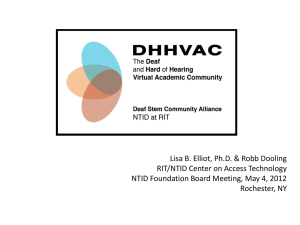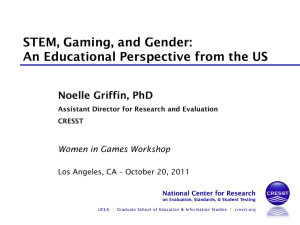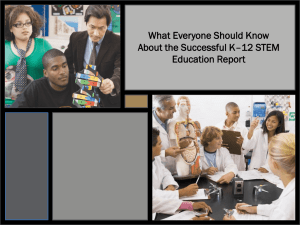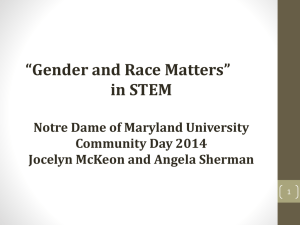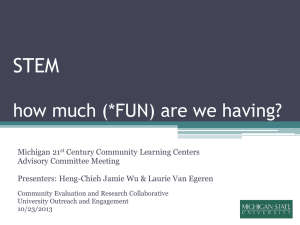PPT - New Haven Science
advertisement
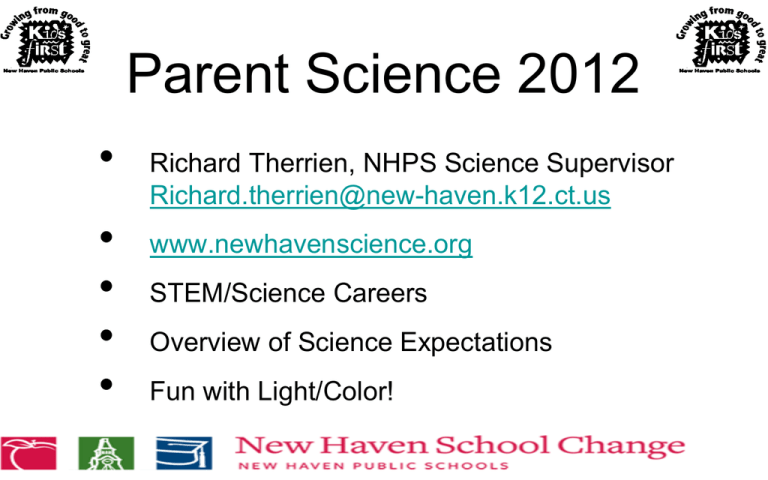
Parent Science 2012 • • • • • Richard Therrien, NHPS Science Supervisor Richard.therrien@new-haven.k12.ct.us www.newhavenscience.org STEM/Science Careers Overview of Science Expectations Fun with Light/Color! NHPS Science Mission Richard Therrien Richard.therrien@new-haven.k12.ct.us www.newhavenscience.org • The mission of the New Haven Public Schools Science Department is to ensure that all students at all levels achieve science literacy,concepts and skills, for science is the key to their future. • • • • • • WHY SCIENCE (STEM)? 75 % of jobs will be in STEM, science, technology, engineering, mathematics Not just STEM careers, it is STEM in every job Technology as a “global knowledge economy” is the future, and it requires different skills. Business and industry want employees with these skills! NHPS has shown success, with the community, with partnerships and dedicated educators… we need to continue at all levels, for all students! For more see: www.newhavenscience.org/STEM, www.ctstemjobs.org What is STEM? • STEM education grows out of the idea that the boundaries between science, technology, engineering, and math are permeable. • Moreover, it asserts that its four disciplines are • interdependent. By endeavoring to blend science, technology, engineering, and math in its approach, STEM education seeks to create 21st century learning opportunities and skill development for all students. NHPS District STEM TIER II GOAL NHPS students will have quality coordinated STEM education and programs, giving them the needed interest and skills for the opportunity to succeed in higher education and have access to STEM careers. Adults will integrate and coordinate of STEM activities, programs, and curriculum and align to 21st Century skills, district goals and procedures. This will result in more students succeeding in STEM courses in middle, high school and college, and more students selecting STEM majors and careers National STEM Crisis • U.S. behind in student indicators. • Foreign nationals ahead in jobs and degrees. • Urban students are falling behind. • Many plans exist to address this. • New national STEM Initiative addresses programs and teachers. A Shrinking Skilled Workforce Pipeline… Stem Pipeline Skill Level Changes Skilled Unskilled 20% 15% Unskilled 60% Professional 20% 1950 Professional 20% Skilled 65% Today National Summit on 21st Century Skills for 21st Century Jobs STEM Pipeline from 9th Grade to Bachelor’s Degree for Low-Income Students in the U.S. 10,000 Students in the Bottom Income Quartile Start the 9th Grade 3,860 of 10,000 6,600 of 10,000 Students Earn a Students Go to College 76 are Declared High School STEM Majors vs 800 Diploma total (8,200 total) 710 of 10,000 Students Earn a Bachelor’s Degree 30 BA/BS in STEM Fields vs 400 CT Careers in STEM • 75% of CT jobs require STEM • Healthcare • Aerospace, • Computers • BioScience, • Financial, • Maritime, • Manufacturing CT STEM Middle skill jobs are STEM (between high school and 4 year college education) • All top 10 2 year degrees are STEM • Most are in healthcare/manufacturing. Manufacturing in Connecticut Manufacturing Establishments in Connecticut = 4,937 Manufacturing Employment =171,800 Average Annual Compensation= $89,238 (26% higher than other sectors) Connecticut Manufacturing Output = $28.9 billion, 13.4% of regional economy New Haven Area • CT Dept of Labor stats for NH: • Health/BioScience Careers (all levels) (technicians, medical, research, labs, practioners, etc....) • Green Technologies & Manufacturing (all levels, high tech skills) • are where the jobs are! Example of choices! STEM CAREERS www.newhavenscience.org/STEM Guide to STEM Careers/Education for New Haven Link to STEM Programs In New Haven, Yale Community Science Parent Guide to Preparation for STEM, (Espanol) Link to CT STEM JOBS Website Interatctive STEM Career Pathways Tool) STEM at CT Community Colleges STEM Programs at CT Community Colleges/State Universities STEM Programs by College STEM Career Descriptions! Green Programs at CT Community Colleges Get Into Energy, Career Pathways in Energy Careers! Profiles of Different Types of Energy Careers: Training Programs for Energy Careers: Scholarships for Energy Careers STEM Students: What Can Parents and Schools Do to Help Kids and Teens Become Interested in STEM? “Fun games — see how science, technology, engineering, and mathematics are actually applicable to real life.” —Engineering Student “Expose them at an early age, show them it is fun and interesting.” —Biomedical Sciences Student “Parents can be more hands on and supportive in teaching their children outside of school to help reinforce what is learned in school. Schools should also have a lot more hands on and visual learning rather than always reading from the textbook. For example, instead of reading about photosynthesis take the students outside and show them photosynthesis.” —Pre-Med Student Base: All College Students (n=500) Q950: What can parents and schools do to help kids and teens become interested in science, technology, engineering and mathematics? The word cloud illustrates keywords used by students to indicate how parents and schools can make STEM more interesting for kids. Larger words represent higher frequencies while smaller words represent lower How can Parents HELP encourage STEM? (see brochure!) • See brochure • • • • • Create INTEREST, be POSITIVE! Guide them to STEM careers! Everyday science, encourage curiosity EXPERIENCES, informal and programs Perseverance, especially in math • • • • NHPS Science 100-150 minutes a week K-6, hands on, inquiry based science instruction. Daily science (6)7-12, 3 years required, many take 4 years. All take Phy/Chem, Biology, Chemistry. Focus on inquiry skills, learning cycle, experimentation, discourse, use of science, technology in society. CtStateDeptEd Science Position Statement 2008 • District Responsibilities include: Ensure that the instructional focus (time) for science is comparable to that provided for language arts and mathematics, and that teachers are able to integrate literacy and numeracy instruction within the context of students’ science learning experiences. • Provide students with multiple opportunities every week to experience inquiry investigations that develop students abilities to question, explore, observe, gather simple data, create graphs, draw conclusions based on the data and build their understanding of natural phenomena. • Ensure that 80 percent of science instructional time is devoted to inquiry-based investigations. COMMUNITY PARTNERS • • • • • • Science Fair, other competitions Yale Community Outreach, Pathways (400 students)trying to coordinate (yale.edu/scienceoutreach) Kids: Demos, SEOP, Peabody, CRISPY, Health, BioBus,SciSat, ExtendedSchool: TAG, LittleScientists, 21stCentury,CT Sci For Kids, SCHOLARS, Evolutions, STEM grant, etc.. CPEP, GearUp, CTInventionConv, STEM21, TeacherTraining: Yale, SummerGrants, Peabody, UNH, etc… Elementary Science In NHPS Science Resource Center Facts: Science Kit Over 2000 kits are sent out each year! Elem Schools get three rotations a year. . District Guidelines specify 2 Periods (100 minutes) of HANDS ON Science a week. Learning Cycle: Engage/Explore first THEN Explain followed by Elaborate, Evaluate. Research shows use of inquiry based programs: - improves mathematical analysis and measurement skills -provides the experiential learning needed to build vocabulary and develop reading/writing skills, especially with group talk. CMT Grade 8 Science Graph #3 in DERG largest gain We focus on Inquiry Skills (•ourapplyanswer to why science process skillswe teach science) • • • • • • read and write science-related texts search scientific databases use mathematics to make sense out of data pose and evaluate arguments based on evidence apply logical conclusions from such arguments Learn Cause and Effect (How one property affects another) HYPOTHESIS: CAUSE and EFFECT • • One property affects another property (factor, stimuli, characteristic, measurement, observation, etc..), both can be observed/measured. How _________ affects _________. Only change one property (factor, thing) at a time. SCIENCE Research • • • • Learned best by learning cycle ( Engage/Explore first THEN Explain followed by Elaborate, Evaluate) Integrates math/literacy Provides the experiential context for other skill areas Fun Example • • • How does the color of a filter change the colors you see? How does the color of light change the colors you see? How do different types of glasses change the way you see things? Color (from fifth grade) We see the color of an object because that color light hits the object, reflects from the object, and comes into our eye Light Paint •How does the color of a filter change the colors you see? (try with red, green filters: look at messages, colored objects, etc..) • How do different types of glasses change the way you see things? • • • Diffraction gratings (like a raindrop/prism), try sunlight/flourescent lights “Holiday” Specs, try point lights, holiday lights 3D: 2 different diffraction gratings that shift the angle of colors, so then red is closer, blue is farther... Try multicolored images... and 3D demo! Both Spheres are the same size. Which appears closer? Move your head from side to side. What happens?



